Daily Life in Willersley Castle
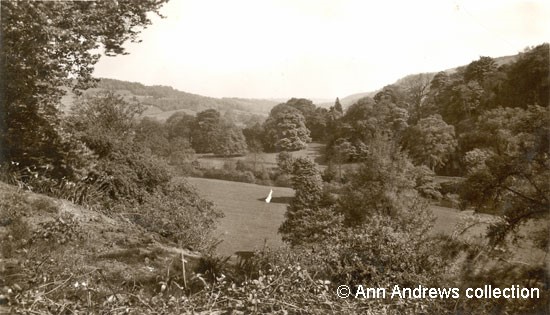
In her daily short but detailed letters to her husband, Stan, Alice Springettt also describes how the mothers were given strict bedrest and care until they were considered fit to leave the bed. This seems to vary depending on the supervising staff and how led they were by conventional methods of the day.
Two days before birth:
Dearest,
Just a note to say that it will be quite alright for you and Mum to come tomorrow (Thursday) to see me. Am still walking about. Have a glamorous night shirt and dressing gown on.
Have had 2 ozs Caster Oil (neat) not even a glass of water with it, a hot bath and 3 injections.
Much love darling,
Alice
Five days after the birth:
‘I am still sitting up in bed, I had a blanket bath this morning. Mum says you took some oat cakes home, what did you think of them? Margaret sends you a big kiss, she is a darling. Mrs. Bingley didn’t do you hard, did she with the charges. What did you have to pay Mrs. Bray?’ (Accommodation charge and hospital fee) (a Wirksworth speciality, similar to crumpets or pancakes)
Six days after the birth:
‘I was allowed to just sit on a chair yesterday afternoon, while the nurses made the bed, my goodness the chair was as you know only two steps from the bed, but I almost fell into it, my legs felt as though they had no bones in them.’
Eight days:
‘Well I was allowed to get up and have walk today, and to the lavatory, what a treat after the old bed pan, you ought to see me try and walk in a straight line, when I got up.’
‘I had a big bundle of cotton wool yesterday to make into little swabs.’ (for washing her baby later.)
‘Well darling, I have just had my hour’s rest and now it’s time to wash again, don’t you have to be clean.’
Her husband Stan was only able to take two days off work from his job in London but was not allowed to hold baby Margaret (see photo below), ‘and how is our Darling baby today? It seems hardly fair that I was only allowed to see her not to hold her.’
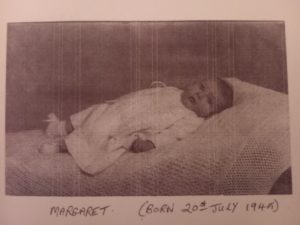
On the subject of daily care, Miss Troth said, “During the convalescent period, the patients find plenty to interest them. On finer days, deck chairs are fetched out, and both mothers and nurses have tea on the terrace, and they walk around the beautiful grounds in their leisure.
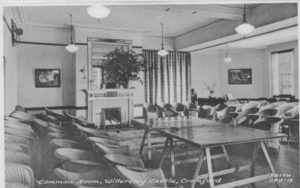
The Mothers’ Hospital Annual Report of 1941 describes how young mothers “throng the terrace lawn, with its sundial and flower-beds, the tree-clad peak behind, the river flowing through the arches of Old Cromford Bridge far below – a charming scene on spring and summer days.”
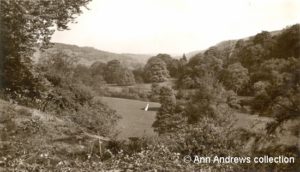
In the evenings local choirs and artists entertain them, and there is a wireless and piano in every ward. As soon as the mothers are allowed to get up, they are taught mothercraft in a special nursery, under the supervision of a trained nurse. “I receive letters from all over the world from the fathers of the babies born here, “Miss Troth concluded, “really grand letters of appreciation, and the mothers often come back to visit me”.
Accounts of their stay there were not always complimentary, especially in the middle of winter when the castle was possibly less appealing, as the only heating came from coal fires in the rooms and some mothers recall the castle being draughty and freezing. The mother of social historian Ken Worpole, amused her family for years with her stories of staying at Willersley,
“Oh, it was terrible at that castle. Cold, dirty rooms, mice running everywhere. We all used to walk around chain-smoking and stamping our feet to keep warm and to frighten the mice away. Although we were all safer there we couldn’t wait to get back to London, despite the bombs.”
Others remember having to the scrub the stone steps and couldn’t wait to return to London to get away from the quietness. The limited plumbing and lack of baths were also issues for both midwives and mothers with baths having to be taken in the middle of a bedroom once a week. “We have a bath here every Sunday night. They haven’t a bathroom, but they have one of those large galvanised baths.” Alice Springett.
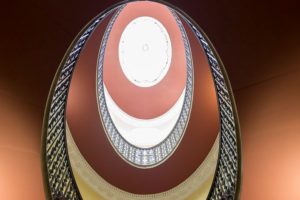
The daunting challenge climbing the staircases to the upper floors in labour was solved by the resourceful making of a sling made from blankets which were hung down over the bannisters to lift women in the later stages of pregnancy to the next floor. Midwife, Hilda Rifkin on a visit to Willersley from The Mothers Hospital recalled seeing a large sling hanging down in front of the staircase which must have filled many mothers with fear!
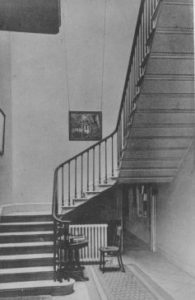
Keeping premature babies alive was also difficult but the midwives showed great ingenuity when they used the laundry cupboard to keep the babies warm and feed them drops of milk with pipettes.
Room 19, known as Primrose Ward, was the main labour ward where many of the women gave birth. The small room had beautiful views looking out onto the valley and Derwent River and in spring rabbits were seen on the lawn in front of the main entrance.


